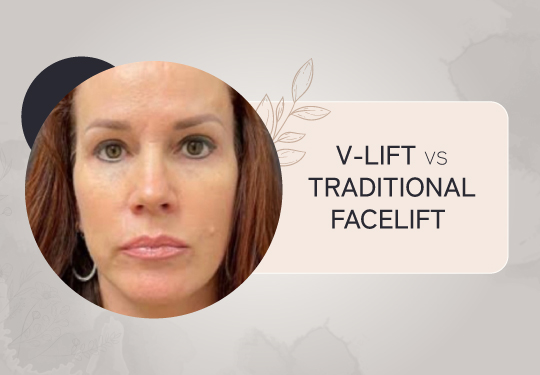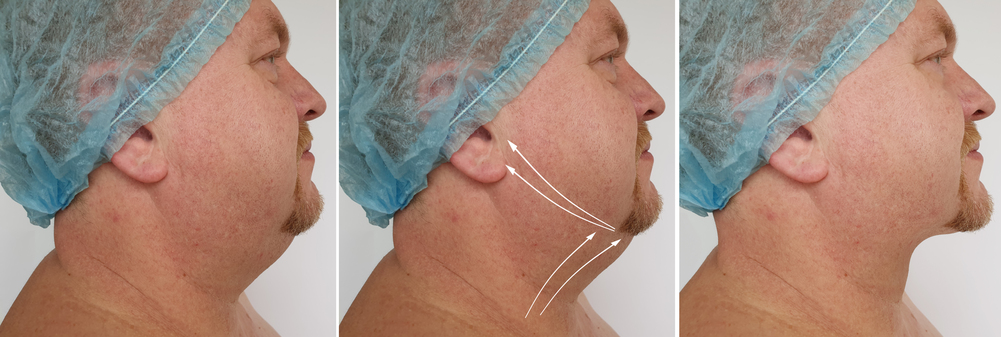

As we age, our skin naturally begins to show signs of wear—wrinkles deepen, skin starts to sag, and that youthful glow we once had may begin to fade. With the rise of advanced cosmetic treatments, there are now several options available for facial rejuvenation. Two popular methods are the V Lift™ (also known as a thread lift) and the traditional facelift. Both offer distinct advantages depending on your aesthetic goals, age, and lifestyle. Deciding which one is right for you involves understanding the differences between the two procedures and how each one fits your unique needs. So, what’s the difference between v-lift vs. traditional facelift and which procedure are you the best candidate for?
The V Lift™ is a relatively new, minimally invasive procedure designed to lift and tighten the skin using absorbable PDO (polydioxanone) threads. These threads are carefully inserted under the skin, providing an instant lift and firming effect. Over time, the threads dissolve, stimulating collagen production, which continues to enhance the skin’s elasticity and texture. Unlike the traditional facelift, the V Lift™ doesn’t involve incisions or general anesthesia, making it a more appealing option for individuals who want to avoid surgery but still achieve a noticeable improvement.
One of the major attractions of the V Lift™ is its quick recovery time. Patients can typically return to their normal activities within a few days, making it an excellent choice for those with busy schedules or who prefer a more subtle, natural enhancement. The procedure itself takes less than an hour, and the results are immediate, though they continue to improve over the following months as collagen production increases. While the results of a V Lift™ are not as long-lasting as those of a traditional facelift, they can last between one and two years, making it an ideal option for those looking for a short-term boost without committing to surgery.
In contrast, the traditional facelift—or rhytidectomy—has long been the gold standard for facial rejuvenation. This surgical procedure addresses more significant signs of aging, such as deep wrinkles, sagging skin, and loose muscles in the face and neck. During a traditional facelift, excess skin is removed, underlying tissues are tightened, and the remaining skin is repositioned for a smoother, more youthful appearance. The surgery typically requires general anesthesia and is performed in a surgical facility, often involving a recovery period of several weeks.
While the traditional facelift is more invasive than the V Lift™, it offers more dramatic and longer-lasting results. Patients who undergo a facelift often enjoy the benefits for 10-15 years, making it a more permanent solution for those with significant skin laxity and advanced aging concerns. For those willing to undergo surgery and invest in a longer recovery time, the traditional facelift can deliver comprehensive results that can significantly turn back the clock.
Deciding between a V Lift™ and a traditional facelift largely depends on your lifestyle, aesthetic goals, and how much time you’re willing to invest in recovery. For many individuals, particularly those in their 30s to early 50s, the V Lift™ may provide just the right amount of lift and rejuvenation. It’s perfect for people experiencing mild to moderate skin laxity who want to refresh their appearance without having surgery. Given its minimal downtime and non-invasive nature, it fits well with the fast-paced, active lifestyles of many people who are juggling careers, family, and social engagements. The V Lift™ allows them to enjoy a rejuvenated appearance without taking time off for a lengthy recovery.
On the other hand, if you’re dealing with more advanced signs of aging—such as deep wrinkles, significant sagging in the jowls or neck, or severely loose skin—the traditional facelift might be the better option. It provides a more comprehensive solution to aging, addressing not just the surface of the skin but also the deeper layers of tissue. The trade-off, however, is that it requires a more significant time commitment, both in terms of undergoing surgery and the recovery period. For those who are prepared for this, the results are often more dramatic and longer-lasting than what the V Lift™ can offer.
 Your skin’s current condition and your age are major factors in deciding which procedure is right for you. If you’re in your 30s or early 40s, a V Lift™ may be sufficient to address early signs of aging, such as slight sagging or fine lines. This age group typically has better skin elasticity, so the V Lift™ can provide a noticeable improvement without the need for more invasive treatments. Additionally, because the V Lift™ stimulates collagen production, it can help maintain the youthful appearance of the skin for a longer period.
Your skin’s current condition and your age are major factors in deciding which procedure is right for you. If you’re in your 30s or early 40s, a V Lift™ may be sufficient to address early signs of aging, such as slight sagging or fine lines. This age group typically has better skin elasticity, so the V Lift™ can provide a noticeable improvement without the need for more invasive treatments. Additionally, because the V Lift™ stimulates collagen production, it can help maintain the youthful appearance of the skin for a longer period.
However, for individuals in their late 40s and beyond, a traditional facelift may be more appropriate. As we age, the skin loses elasticity, and deeper folds and wrinkles begin to appear. These signs of aging are often too advanced for a V Lift™ to correct effectively. A traditional facelift can provide a more comprehensive solution, tightening not just the skin but also the underlying muscles and tissues, creating a smoother, more youthful contour that can last for years.
One of the primary differences between the V Lift™ and a traditional facelift is the recovery time. The V Lift™ has become increasingly popular because of its minimal downtime. Most patients can return to work and normal activities within 24-48 hours, with only mild swelling or bruising. There’s no need for extensive aftercare, making it an ideal choice for people who want a quick fix without a major disruption to their lives.
In contrast, the traditional facelift requires a longer recovery period. Swelling and bruising are common after surgery, and most patients need at least two to three weeks before they feel comfortable returning to public life. While this can be a drawback for those with busy schedules, the extended recovery is offset by the long-term, dramatic results that the procedure provides. Over several months, as swelling subsides and the skin adjusts to its new position, the full effects of the facelift become more apparent, giving patients a youthful, rejuvenated appearance.
Cost is another important factor that can influence your decision. A V Lift™ typically costs less than a traditional facelift, with prices ranging from $1,500 to $4,500 depending on the extent of the treatment. Since the results are shorter-lived, some patients may choose to repeat the procedure every few years to maintain their results. In contrast, a traditional facelift is a more significant financial investment, often ranging from $7,000 to $15,000, but the results can last for a decade or more.
For individuals who are looking for a long-term solution, the traditional facelift may ultimately provide more value, as it reduces the need for frequent touch-ups. However, if you’re looking for a more affordable option with immediate, though less dramatic results, the V Lift™ could be the better choice.
Hearing from those who have undergone these procedures can offer valuable insight into the decision-making process. Take, for instance, Melissa, a 45-year-old resident of West Palm Beach. She chose the V Lift™ because she wanted a subtle enhancement before her daughter’s wedding. “I didn’t have time for surgery, and the V Lift™ gave me just enough of a lift to feel confident and refreshed. The best part was that I was back at work the next day!”
 In contrast, John, a 60-year-old retiree from Boca Raton, opted for the traditional facelift. “I’ve always been active, but I was starting to look much older than I felt. The facelift was a big decision, but the results are incredible. It’s been two years, and I still feel like it was the best investment I made. My wife says I look 15 years younger.”
In contrast, John, a 60-year-old retiree from Boca Raton, opted for the traditional facelift. “I’ve always been active, but I was starting to look much older than I felt. The facelift was a big decision, but the results are incredible. It’s been two years, and I still feel like it was the best investment I made. My wife says I look 15 years younger.”
These testimonials reflect how different procedures can suit different lifestyles and goals. Whether opting for a non-invasive V Lift™ or committing to the long-term results of a traditional facelift, each patient’s journey is personal, and finding the right procedure depends on individual preferences and needs.
Ultimately, the decision between a V Lift™ and a traditional facelift depends on several factors, including the extent of your aging concerns, your lifestyle, your budget, and how much recovery time you can afford. The V Lift™ is a fantastic option for those looking for a subtle lift with minimal downtime, while the traditional facelift offers more dramatic and longer-lasting results for individuals facing more significant aging issues.
Before making a decision, it’s important to consult with a skilled plastic surgeon who can evaluate your specific needs and recommend the best approach. Both procedures have their merits, and with the guidance of a trusted expert, you can achieve the appearance you’re seeking.